
Elephant and Eclipse
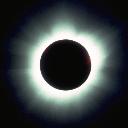

|
Eclipse 2001 Elephant and Eclipse |

|
| by John Walker | ||
Of course the image of the eclipsed Sun and trumpeting elephant is a composite! I was lucky enough to catch the elephant at the moment he raised his trunk and bellowed at our Land Rover, and to have the slides of totality from eclipse day come out fine, but nobody is lucky enough to see both at the same time. At least the individual pieces are genuine, and I think the result brings the wildlife and eclipse aspects of the trip together nicely for the title page.
Enough confession...the rest of this document explains the details of how I assembled the image. If you've never experimented with an image processing program, you may get lost in or bored by the following discussion; if so, just go back to the title page and pick up where you left off.
Still with me? Great!...onward to the nitty-gritty.
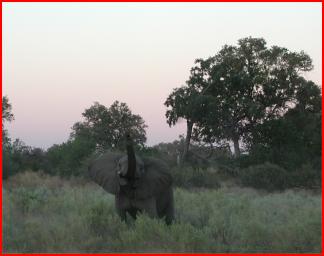 First of all, I needed an interesting wildlife shot with
sufficient open and cloudless sky to insert the image of
the eclipsed Sun. The image of the trumpeting elephant not only
met these criteria, it had the additional merit of having
been taken near dusk, when the absence of shadows and soft hues
approximated those during a total eclipse. Better still, the
elephant was positioned against the glow of twilight which,
with a little work, could be made to approximate the view
toward the "360° twilight" characteristic of totality. A
description of the circumstances surrounding this picture
is given in the
Images
of Africa document.
First of all, I needed an interesting wildlife shot with
sufficient open and cloudless sky to insert the image of
the eclipsed Sun. The image of the trumpeting elephant not only
met these criteria, it had the additional merit of having
been taken near dusk, when the absence of shadows and soft hues
approximated those during a total eclipse. Better still, the
elephant was positioned against the glow of twilight which,
with a little work, could be made to approximate the view
toward the "360° twilight" characteristic of totality. A
description of the circumstances surrounding this picture
is given in the
Images
of Africa document.
I've added a red border to this and the images below to
delineate their boundaries against the page background.
This border does not appear in the actual composite
image or its components.

| × |
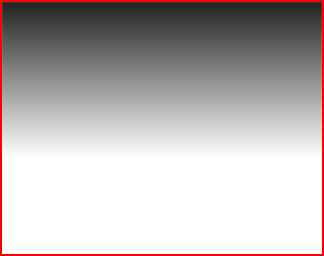
| = |
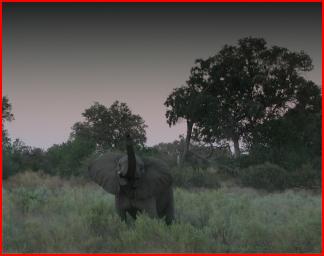 While the horizon in the original image displayed convincingly
pink twilight colours, what we're looking at here is the
Earth's shadow rising into the sky, with pink light
refracted through the atmosphere shading into the blue of sky
still scattering the direct light of the Sun. During a total
eclipse, the illumination works the other way; the sky around
the Sun is dark, often sufficiently so to reveal bright stars and
planets, but around the horizon light from areas not in
totality brightens the sky, creating the characteristic 360°
twilight.
While the horizon in the original image displayed convincingly
pink twilight colours, what we're looking at here is the
Earth's shadow rising into the sky, with pink light
refracted through the atmosphere shading into the blue of sky
still scattering the direct light of the Sun. During a total
eclipse, the illumination works the other way; the sky around
the Sun is dark, often sufficiently so to reveal bright stars and
planets, but around the horizon light from areas not in
totality brightens the sky, creating the characteristic 360°
twilight.
To approximate this, I created a gradient mask, at right above,
which was white from the bottom of the frame to the horizon, then darker with
increasing elevation in the sky. Multiplying the original image by this mask had the
effect of leaving the elephant and foreground vegetation unchanged, while
smoothly darkening the sky from the horizon on up. The mask also, of course,
darkened the trees silhouetted against the sky, but since they were already
back-lit this isn't too obvious. You'll occasionally see an optical gradient
filter like this used in low-budget movies attempting to make scenes shot in
daylight look like dawn or dusk; prominent shadows often give the
game away. Since I started with a genuine twilight shot, I didn't
have to contend with shadows and the effect, shown at right, was satisfactory.

| + |
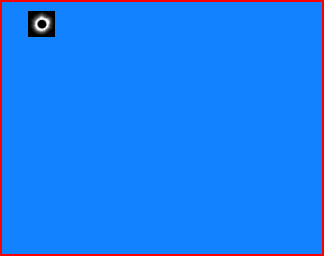
| = |
 The next step was to add the eclipsed Sun. I
selected an image from the
Eclipse Photo Gallery
with a well-defined but not extremely extended corona.
This is typical of snapshots of the eclipsed
Sun and consistent with an exposure which would render the landscape
and elephant as they appear in the image. A long exposure which
showed extended coronal streamers would have blurred the
elephant's trunk, which was clearly moving as it trumpeted.
The next step was to add the eclipsed Sun. I
selected an image from the
Eclipse Photo Gallery
with a well-defined but not extremely extended corona.
This is typical of snapshots of the eclipsed
Sun and consistent with an exposure which would render the landscape
and elephant as they appear in the image. A long exposure which
showed extended coronal streamers would have blurred the
elephant's trunk, which was clearly moving as it trumpeted.
I took the chosen image of totality, cropped around the Sun,
and scaled the Sun to a size which fit into the image as I
intended. I then pasted the image of the corona onto a new
layer with a transparent background, indicated in blue above.
The blue region has no effect in the image processing
operation. I positioned the Sun in the sky to achieve the
desired composition, and summed it with the first two layers,
lightening the background sky according to the intensity of the
corona. Black regions leave the sky as-is, pure white overlays
the sky, and intermediate shades proportionately lighten the
existing sky colour. (Note that since black regions leave the
underlying image unaffected, a completely black background
would have had the same effect as the transparent one I used.
The image processing program I used,
Jasc
Paint Shop Pro, provides transparency so I went
ahead and used it.)

| - |

| = |
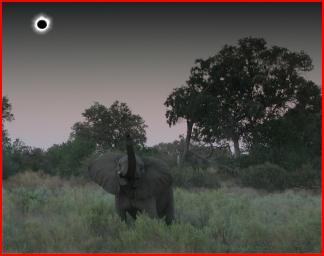 Since black regions have no effect on the background image, adding the corona to
the sky in Step 2 left the sky behind the Moon unchanged. That's not right--we
want Moon's disc to be black. So, I selected the circular disc of the Moon with
a small border of corona to blend smoothly, then copied and pasted it to
yet another layer with a transparent background. I then aligned this with the
centre of the corona and overlaid it on the first three layers. The blue transparent
background leaves the existing layers unchanged, but the image of the Moon's disc
overlays the sky at the centre of the corona, achieving the desired effect.
Since black regions have no effect on the background image, adding the corona to
the sky in Step 2 left the sky behind the Moon unchanged. That's not right--we
want Moon's disc to be black. So, I selected the circular disc of the Moon with
a small border of corona to blend smoothly, then copied and pasted it to
yet another layer with a transparent background. I then aligned this with the
centre of the corona and overlaid it on the first three layers. The blue transparent
background leaves the existing layers unchanged, but the image of the Moon's disc
overlays the sky at the centre of the corona, achieving the desired effect.
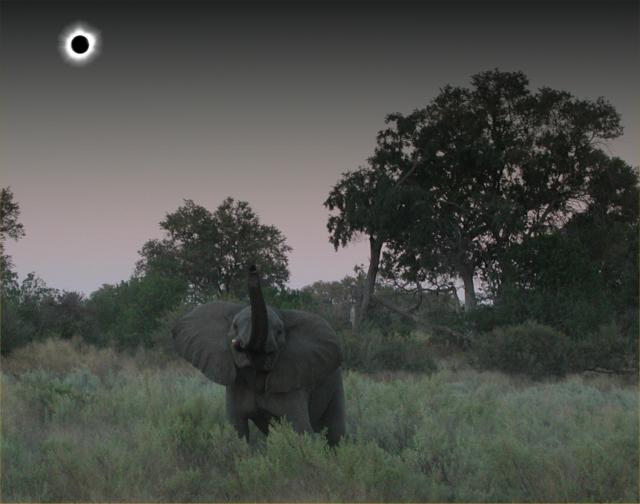
The result of these manipulations is shown above full size. While it looks credible at a first glance, it doesn't require a very detailed examination to show that the picture is obviously a composite.
First of all, the Sun is way too big, although one can always argue it's a telephoto shot which happened to catch a distant elephant and the eclipsed Sun...right. The goal was effect, not authenticity; if I scaled the Sun to a more credible size it would only be a little fuzzy spot in the sky. I opted for the big Sun. (Artists almost always paint the Sun and Moon much larger than they actually appear in the sky--I'm digitally perpetuating that tradition here.)
Second, no amount of arm-waving can explain away the Sun's being much too low in the sky. Seen from Earth, the Sun and Moon both subtend about half a degree. If you count how far the Sun is above the horizon in units of the Moon's diameter, you find the altitude of the Sun in the sky is about 15 Moon diameters or 7.5°. Gotcha! The table of events for this eclipse indicates the Sun was actually 31° above the horizon at the time of totality, providing proof immune to even the most convoluted arguments that the picture is a fabrication.
In fact, whenever you see a picture of the eclipsed Sun against a picturesque foreground, it's amusing to work out the details to see whether the picture could possibly be genuine. In many cases, you'll find it couldn't. But there's no harm in that (unless the intent is to deceive). It's fun to create interesting images, whether digitally or in the darkroom, and equally fun to spot the trickery and figure out how it was done. I hope you've enjoyed this look behind the curtain at the creation and deconstruction of such an image.